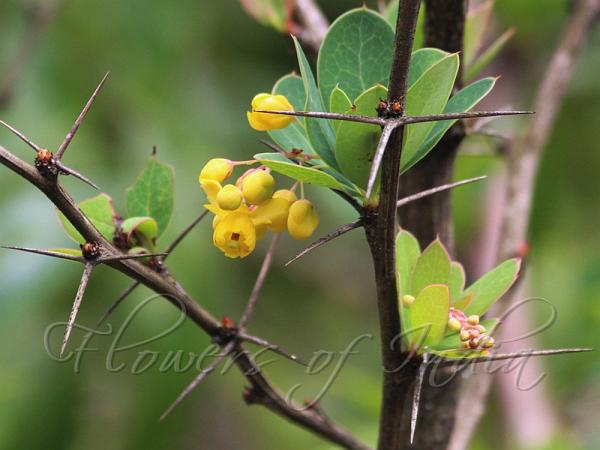|
| Dye Barberry |
|

|

|
|
|
|
Photo: |
Botanical name: Berberis tinctoria Family: Berberidaceae (Barberry family)
Dye Barberry is an evergreen, erect shrub,
variable in size and form, often 1-2 m tall, in forests up to 4 m tall.
Stems are furrowed, pale brown; wood very tough, bright yellow; spines
3-fid, 1.5-3 cm long. Leaves are obovate, entire, rarely with 1 or 2
spinules, blunt, mucronate, 1.5-3.5 x 0.7-1.3 cm, thick, purplish when
young, papillose, dull above, powdery beneath; leaf-stalks 2-5 mm long.
Flowers are borne in 10-20 flowered racemes or panicles, 3.5-5 cm long,
yellow; flower-stalks 5-10 mm long, red. Prophylls about 1 x 0.5 mm.
Outer sepals are obovate, pointed about 7 x 5 mm; the inner ovate or
obovate, blunt, about 4 x 2.5 mm. Petals are obovate, about 6 x 4.5 mm,
clawed; claws glandular at base. Stamens are about 5 mm long, short
apiculate. Ovary is stipitate. Berries are spindle shaped, 9-10 x about
5 mm excluding 1-1.5 mm long dry style and large round stigma still
attached, purplish red turning dark blue with glaucous bloom. Dye
Barberry is found in India and China.
Medicinal uses: The roots of Dye Barberry
are used for curing jaundice, and the leaf parts are used for the
purpose of cancer treatment to some extent by the tribal and local
people.
The roots of Dye Barberry
are used for curing jaundice, and the leaf parts are used for the
purpose of cancer treatment to some extent by the tribal and local
people.
Medicinal uses:
 The roots of Dye Barberry
are used for curing jaundice, and the leaf parts are used for the
purpose of cancer treatment to some extent by the tribal and local
people.
The roots of Dye Barberry
are used for curing jaundice, and the leaf parts are used for the
purpose of cancer treatment to some extent by the tribal and local
people. | Identification credit: S. Jeevith | Photographed in The Nilgiris, Tamil Nadu. |
• Is this flower misidentified? If yes,